tow RENAULT MEGANE 2005 X84 / 2.G Owner's Manual
[x] Cancel search | Manufacturer: RENAULT, Model Year: 2005, Model line: MEGANE, Model: RENAULT MEGANE 2005 X84 / 2.GPages: 250, PDF Size: 5.72 MB
Page 191 of 250
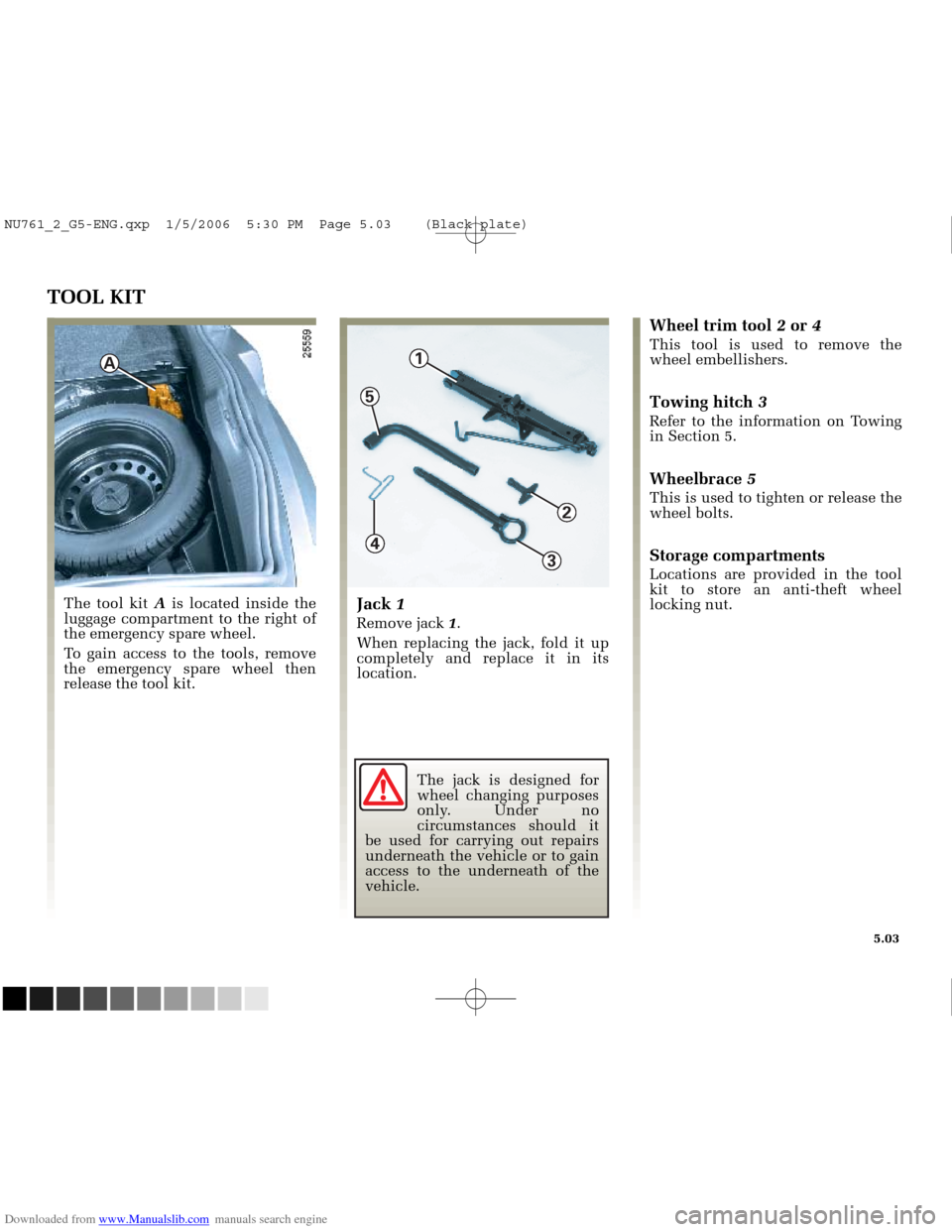
Downloaded from www.Manualslib.com manuals search engine
1
3
4
2
5
A
NU761_2_G5-FRA.qxd 4/11/05 11:09 Page 5.03
5.03
TOOL KIT
The tool kit Ais located inside the
luggage compartment to the right of
the emergency spare wheel.
To gain access to the tools, remove
the emergency spare wheel then
release the tool kit.
Wheel trim tool 2or 4
This tool is used to remove the
wheel embellishers.
Towing hitch 3
Refer to the information on Towing
in Section 5.
Wheelbrace 5
This is used to tighten or release the
wheel bolts.
Storage compartments
Locations are provided in the tool
kit to store an anti-theft wheel
locking nut.
Jack 1
Remove jack 1.
When replacing the jack, fold it up
completely and replace it in its
location.
The jack is designed for
wheel changing purposes
only. Under no
circumstances should it
be used for carrying out repairs
underneath the vehicle or to gain
access to the underneath of the
vehicle.
NU761_2_G5-ENG.qxp 1/5/2006 5:30 PM Page 5.03 (Black plate)
Page 201 of 250
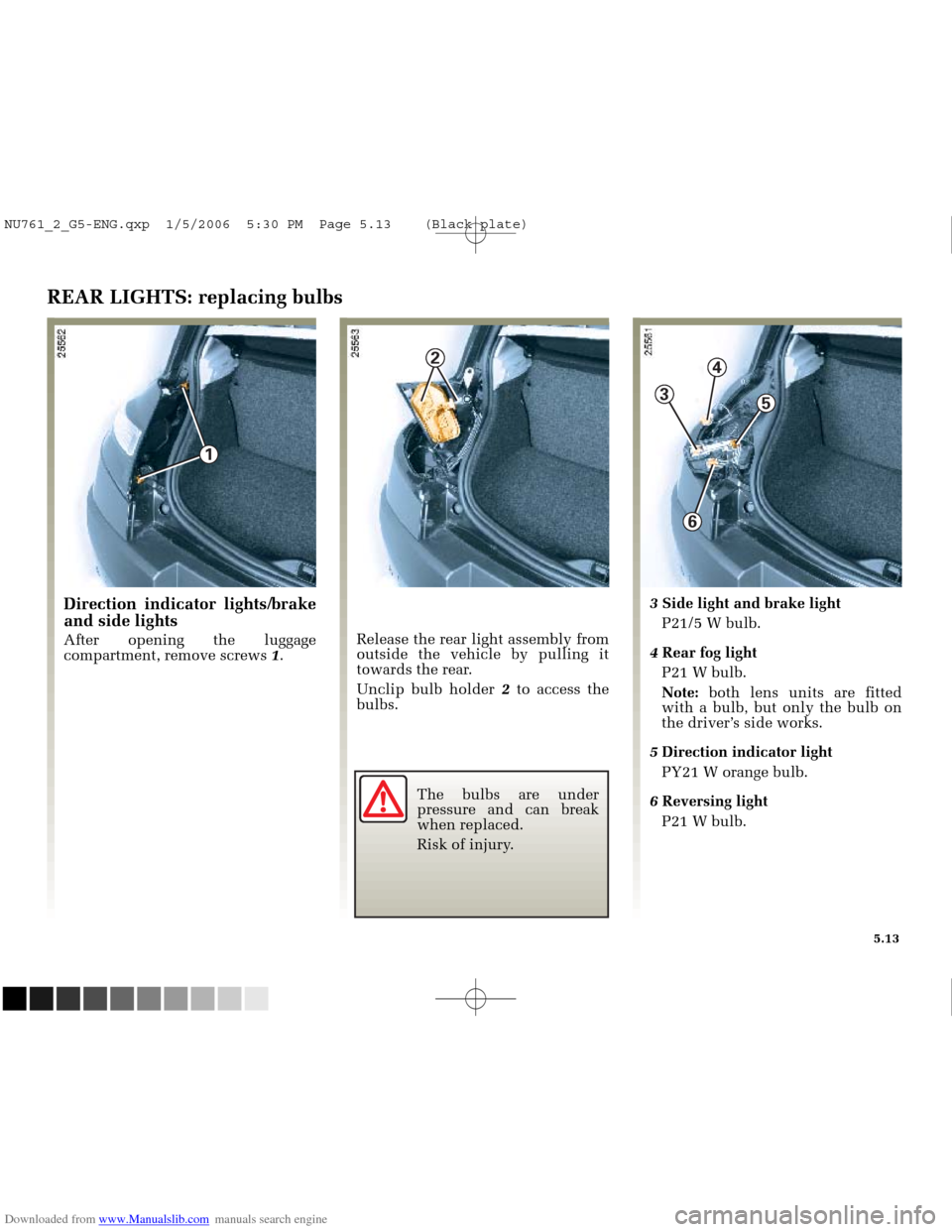
Downloaded from www.Manualslib.com manuals search engine
1
2
6
3
4
5
NU761_2_G5-FRA.qxd 4/11/05 11:09 Page 5.13
5.13
REAR LIGHTS: replacing bulbs
Release the rear light assembly from
outside the vehicle by pulling it
towards the rear.
Unclip bulb holder 2to access the
bulbs.
Direction indicator lights/brake
and side lights
After opening the luggage
compartment, remove screws 1. 3
Side light and brake light
P21/5 W bulb.
4 Rear fog light
P21 W bulb.
Note: both lens units are fitted
with a bulb, but only the bulb on
the driver’s side works.
5 Direction indicator light
PY21 W orange bulb.
6 Reversing light
P21 W bulb.
The bulbs are under
pressure and can break
when replaced.
Risk of injury.
NU761_2_G5-ENG.qxp 1/5/2006 5:30 PM Page 5.13 (Black plate)
Page 209 of 250

Downloaded from www.Manualslib.com manuals search engine
NU761_2_G5-FRA.qxd 4/11/05 11:09 Page 5.21
5.21
BATTERY: troubleshooting (continued)
Connecting a battery charger
The battery charger should be
compatible with a battery with a
nominal voltage of 12 Volts.
With the engine switched off, it is
essential to disconnect the cables
connected to both battery terminals,
starting with the negative terminal .
Do not disconnect the battery when
the engine is running. Follow the
manufacturer’s instructions for the
battery charger you are using.
Only a well-charged and well-
maintained battery will have a long
and useful life and enable you to
start the vehicle’s engine normally.
The battery must be kept clean and
dry.
Have the battery’s charge status
checked regularly:
Especially if you use your vehicle for short journeys or for frequent
driving in town. When the external temperature
drops (in winter), the charge
decreases . In winter, only use
electrical equipment which is
really necessary.
Finally, you should understand that the charge decreases naturally
as a result of certain “permanent
electrical consumers” such as the
clock, After-Sales accessories, etc.
When many accessories are fitted to
the vehicle, have them connected
to + after ignition feed . In this case,
it is advisable to have your vehicle
fitted with a battery which has an
increased capacity. Contact your
RENAULT Dealer. If your vehicle is to be left stationary
for a relatively long time, disconnect
the battery or have it recharged
regularly, in particular during cold
weather. The equipment with a
memory, radio etc. will then have to
be reprogrammed. The battery must
be stored in a cool dry place,
protected from frost.
Special procedures may
be required to charge
some batteries. Contact
your RENAULT Dealer.
Avoid all risk of sparks which
may cause an immediate
explosion and charge the battery
in a well-ventilated area. Risk of
serious injury.
NU761_2_G5-ENG.qxp 1/5/2006 5:30 PM Page 5.21 (Black plate)
Page 216 of 250

Downloaded from www.Manualslib.com manuals search engine
NU761_2_G5-FRA.qxd 4/11/05 11:10 Page 5.28
5.28
TOWING: breakdown
Press the Start/Stop button twice in
succession once towing is finished
(risk of running down the battery).
Furthermore, it is essential to
respect the towing regulations
defined in the legislation of the
country concerned and, if your
vehicle is the towing vehicle, do not
exceed the towing weight of your
vehicle. Contact your RENAULT
Dealer.Towing procedure
Before any towing, check that the
steering column is not locked.
If it is not locked, insert the
RENAULT card into the reader and
press the start/stop button for five
seconds without pressing on the
pedals. The steering column
unlocks, the vehicle accessory
functions are supplied with power
and you can use the lights (stop
lights, directional indicator lights,
etc.): the vehicle must have its lights
on at night.
Do not remove the RENAULT card
from the reader at any point when
the vehicle is being towed.
Towing a vehicle with
automatic transmission: special
information
Engine switched off: The gearbox is
no longer lubricated. It is preferable
to tow this type of vehicle on a
trailer or tow it with the front
wheels off the ground.
Under exceptional circumstances ,
you may tow the vehicle with all
four wheels on the ground, only
going forward, with the gear lever in
the N position, and for a distance
not exceeding 30 miles (50 km).
If the lever is stuck at P,
even though you are
depressing the brake
pedal, the lever can be
released manually.
To do this, unclip the upper
section of the cover at the base of
the lever.
Press simultaneously on the mark
on the gaiter and the unlocking
button on the lever.
NU761_2_G5-ENG.qxp 1/5/2006 5:30 PM Page 5.28 (Black plate)
Page 217 of 250
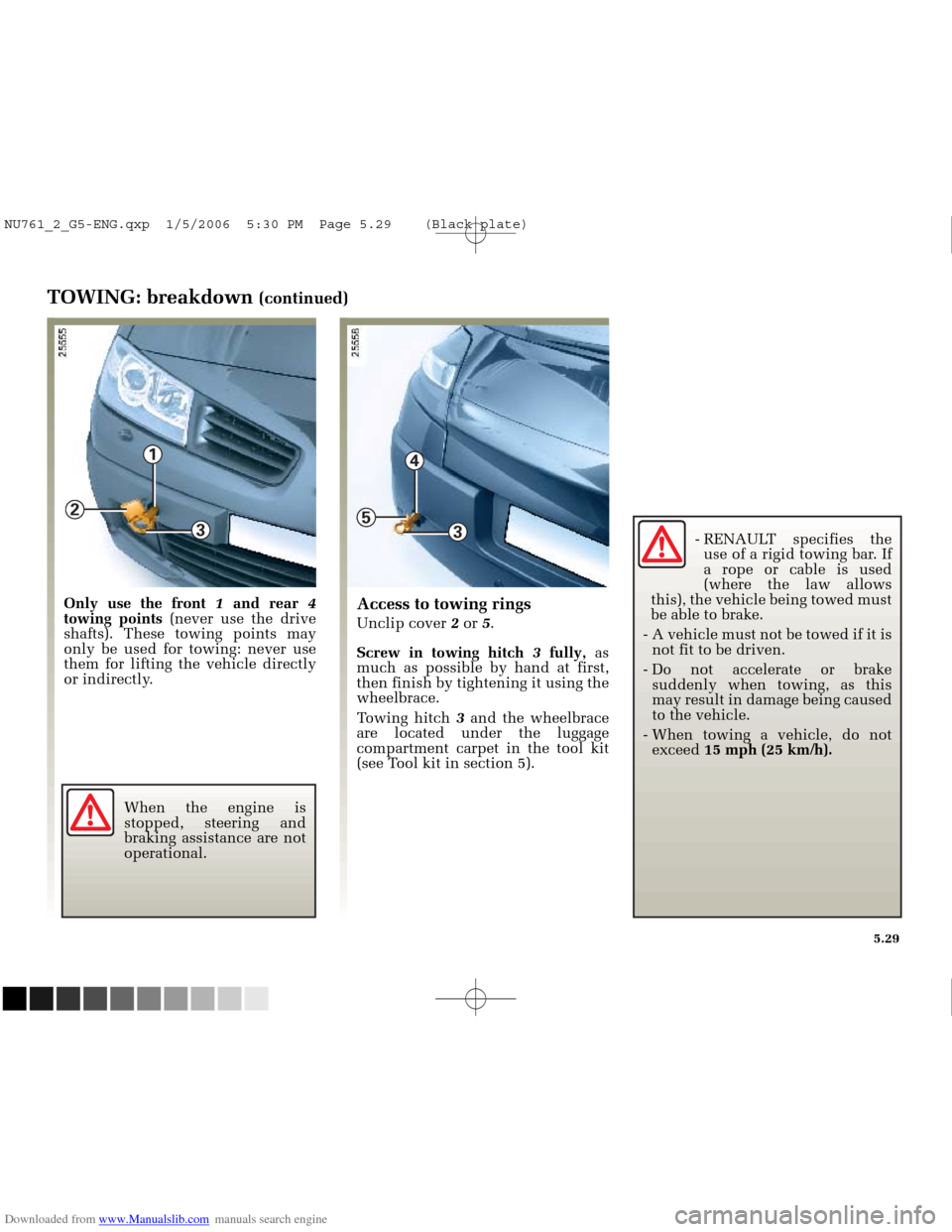
Downloaded from www.Manualslib.com manuals search engine
3
1
2
3
4
5
NU761_2_G5-FRA.qxd 4/11/05 11:10 Page 5.29
5.29
TOWING: breakdown (continued)
Only use the front 1and rear 4
towing points (never use the drive
shafts). These towing points may
only be used for towing: never use
them for lifting the vehicle directly
or indirectly.Access to towing rings
Unclip cover 2or 5.
Screw in towing hitch 3fully, as
much as possible by hand at first,
then finish by tightening it using the
wheelbrace.
Towing hitch 3and the wheelbrace
are located under the luggage
compartment carpet in the tool kit
(see Tool kit in section 5).
When the engine is
stopped, steering and
braking assistance are not
operational. - RENAULT specifies the
use of a rigid towing bar. If
a rope or cable is used
(where the law allows
this), the vehicle being towed must
be able to brake.
- A vehicle must not be towed if it is not fit to be driven.
- Do not accelerate or brake suddenly when towing, as this
may result in damage being caused
to the vehicle.
- When towing a vehicle, do not exceed 15 mph (25 km/h).
NU761_2_G5-ENG.qxp 1/5/2006 5:30 PM Page 5.29 (Black plate)
Page 218 of 250
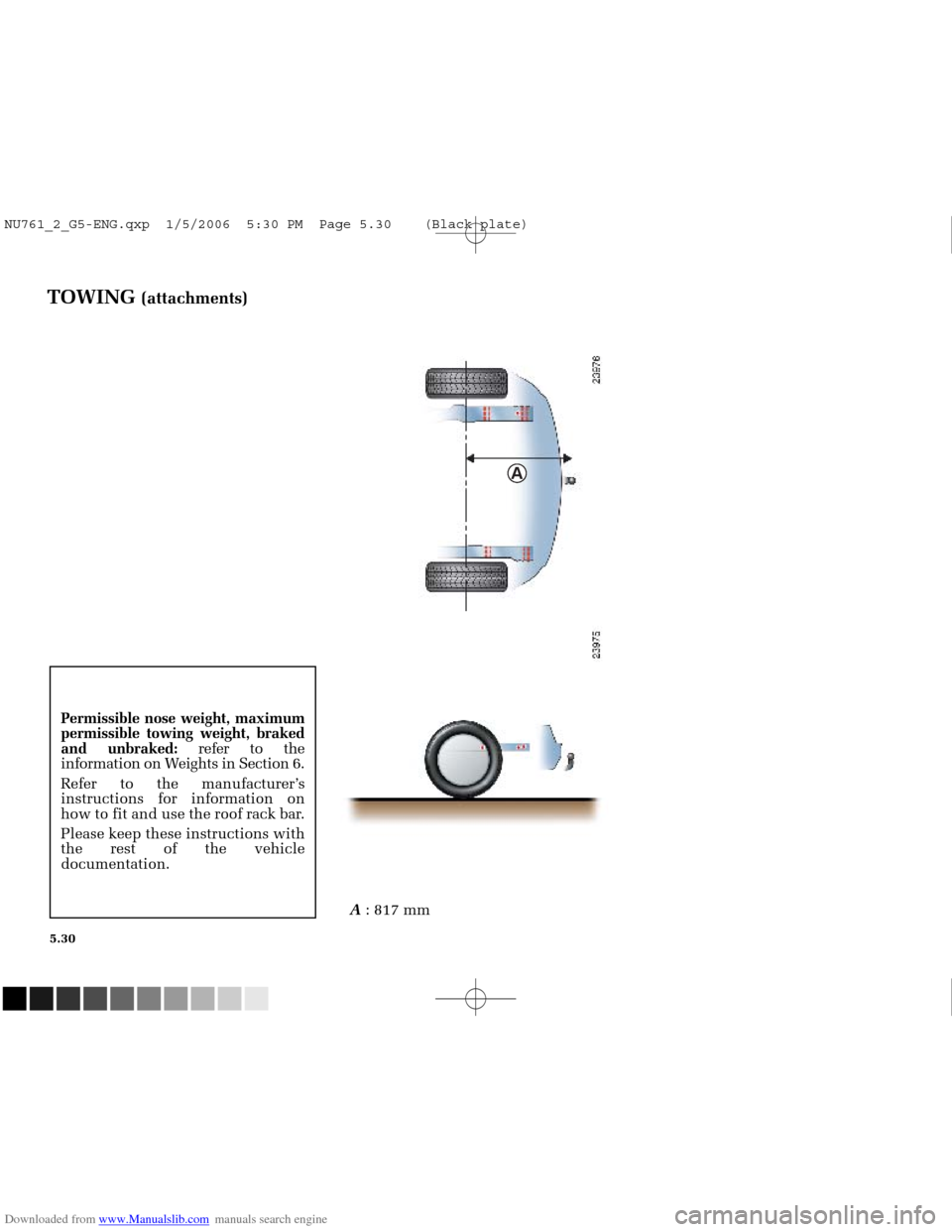
Downloaded from www.Manualslib.com manuals search engine
A
NU761_2_G5-FRA.qxd 4/11/05 11:10 Page 5.30
5.30
TOWING (attachments)
Permissible nose weight, maximum
permissible towing weight, braked
and unbraked:refer to the
information on Weights in Section 6.
Refer to the manufacturer’s
instructions for information on
how to fit and use the roof rack bar.
Please keep these instructions with
the rest of the vehicle
documentation.
A : 817 mm
NU761_2_G5-ENG.qxp 1/5/2006 5:30 PM Page 5.30 (Black plate)
Page 227 of 250

Downloaded from www.Manualslib.com manuals search engine
NU761_2_G6-FRA.qxd 4/11/05 11:10 Page 6.01
6.01
Section 6: Technical specifications
Vehicle identification plates ........................................................................\
.....................................................6.02 ➟6.04
Engine specifications
........................................................................\
....................................................... ........................6.05
Towing weights
........................................................................\
....................................................... .......................6.06 - 6.17
Weights
........................................................................\
....................................................... ...................................6.06 ➟6.17
Dimensions
........................................................................\
....................................................... .........................................6.18
Replacement parts
........................................................................\
....................................................... .............................6.19
NU761_2_G6-ENG.qxp 03-Jan-06 20:51 Page 6.01 (Black/Process Black\
plate)
Page 228 of 250
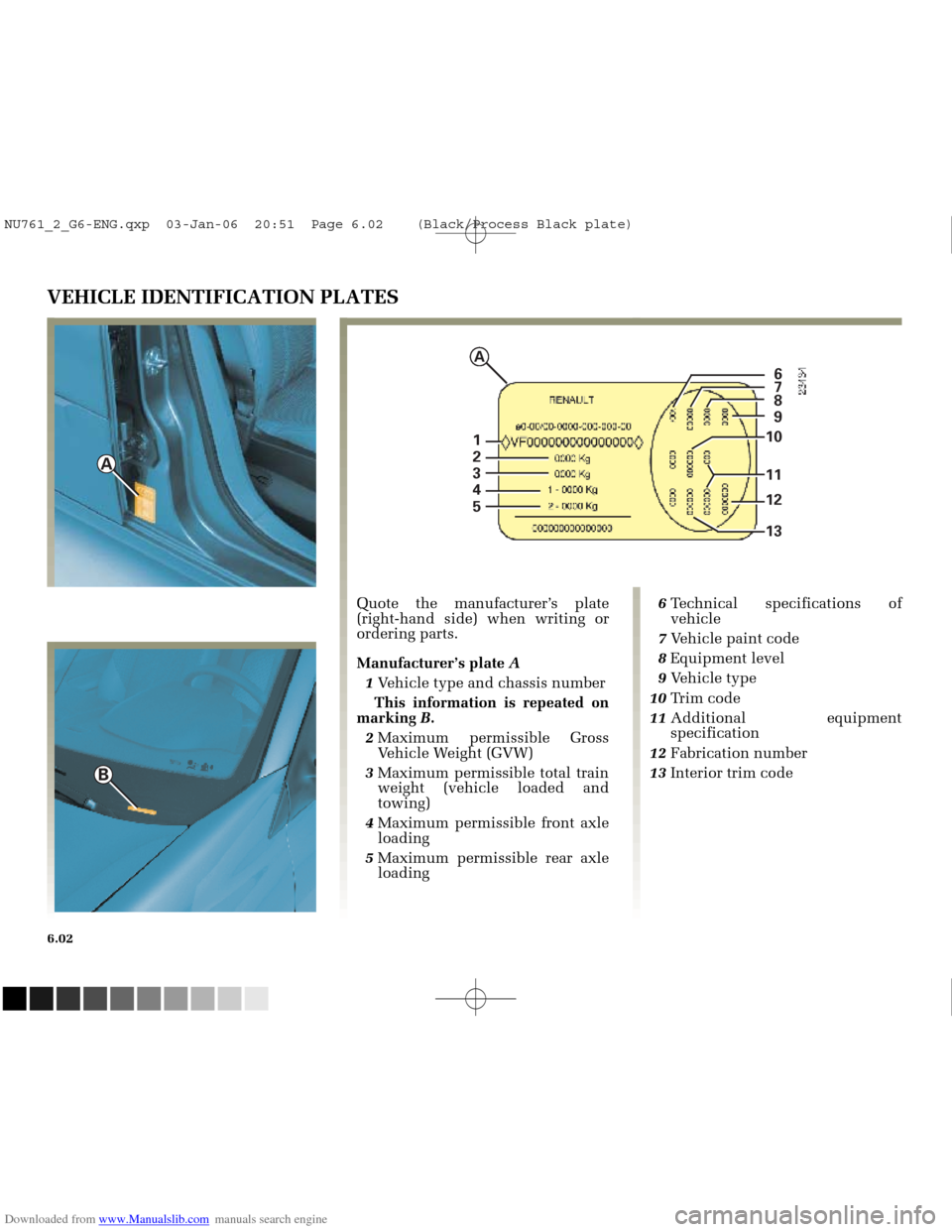
Downloaded from www.Manualslib.com manuals search engine
A
B
1
2
3
4
56
7
8
9
10
11
12
13
A
NU761_2_G6-FRA.qxd 4/11/05 11:10 Page 6.02
6.02
Quote the manufacturer’s plate
(right-hand side) when writing or
ordering parts.
Manufacturer’s plate A
1 Vehicle type and chassis number
This information is repeated on
marking B.
2 Maximum permissible Gross
Vehicle Weight (GVW)
3 Maximum permissible total train
weight (vehicle loaded and
towing)
4 Maximum permissible front axle
loading
5 Maximum permissible rear axle
loading 6
Technical specifications of
vehicle
7 Vehicle paint code
8 Equipment level
9 Vehicle type
10 Trim code
11 Additional equipment
specification
12 Fabrication number
13 Interior trim code
VEHICLE IDENTIFICATION PLATES
NU761_2_G6-ENG.qxp 03-Jan-06 20:51 Page 6.02 (Black/Process Black\
plate)
Page 232 of 250

Downloaded from www.Manualslib.com manuals search engine
NU761_2_G6-FRA.qxd 4/11/05 11:11 Page 6.06
6.06
WEIGHTS (in kg)- Basic vehicle with no options; may change during the year and dependin\
g on the
country of marketing: consult your RENAULT Dealer.
Versions 1.4 16V
CM0BCM08
CM1A
CM0H CM1S BM0B
BM08
BM1A
BM0H BM1S CM0C
CM0J
CM1B
CM1R BM0C
BM0J
BM1B
BM1R BM0P CM0Y BM0Y
1 145 710
435
1 015930
1 165
710
455 1 155
715
440 1 175
715
460 1 218
749
469 1 210
715
495
1 015965 1 230
715
515
1 695 650
1 715
1 300 1 725 1 723 1 740 1 760
1 000
2 700 75
80 (including carrying equipment)
2 750 2 700 2 750 2 700 2 750
950 1 000 950
1 350 1 250 1 300
1.6 16V
Vehicle type
(see vehicle identification plate)
Kerb weight Total
without Front
driver Rear
Maximum permissible Front
axle weight Rear
Maximum permissible all-up weight
Maximum permissible towing weight
unbraked
Maximum permissible towing
weight braked (1) driver only
other cases
Gross train weight
(= Maximum permissible all-up weight +
trailer)
Permissible nose weight
Maximum permissible load on roof rack
NU761_2_G6-ENG.qxp 03-Jan-06 20:51 Page 6.06 (Black/Process Black\
plate)
Page 233 of 250
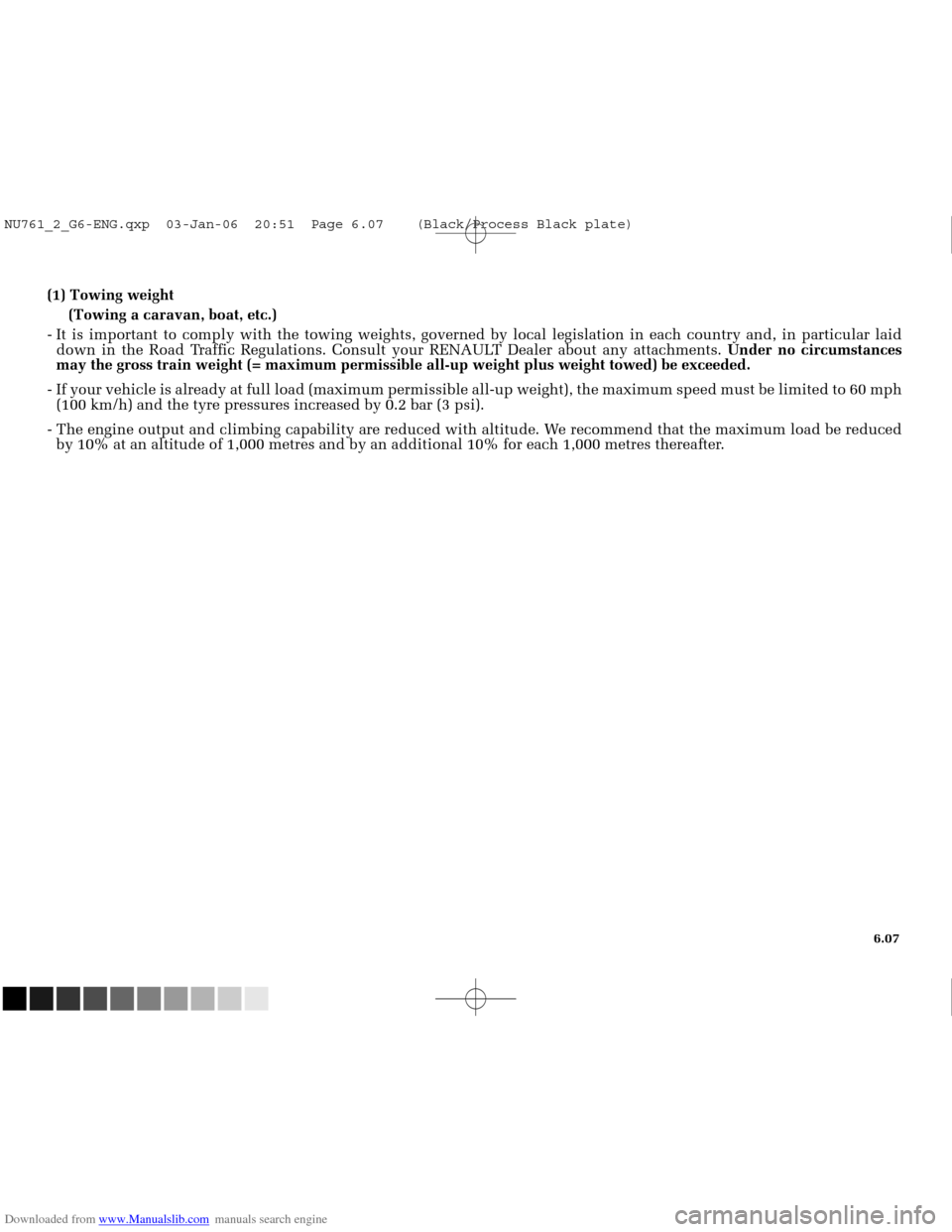
Downloaded from www.Manualslib.com manuals search engine
NU761_2_G6-FRA.qxd 4/11/05 11:11 Page 6.07
6.07
(1) Towing weight(Towing a caravan, boat, etc.)
- It is important to comply with the towing weights, governed by local leg\
islation in each country and, in particular laid down in the Road Traffic Regulations. Consult your RENAULT Dealer about any attachments. Under no circumstances
may the gross train weight (= maximum permissible all-up weight plus we\
ight towed) be exceeded.
- If your vehicle is already at full load (maximum permissible all-up wei\
ght), the maximum speed must be limited to 60 mph (100 km/h) and the tyre pressures increased by 0.2 bar (3 psi).
- The engine output and climbing capability are reduced with altitude. We recommend that the maximum load be reduced by 10% at an altitude of 1,000 metres and by an additional 10% for each \
1,000 metres thereafter.
NU761_2_G6-ENG.qxp 03-Jan-06 20:51 Page 6.07 (Black/Process Black\
plate)